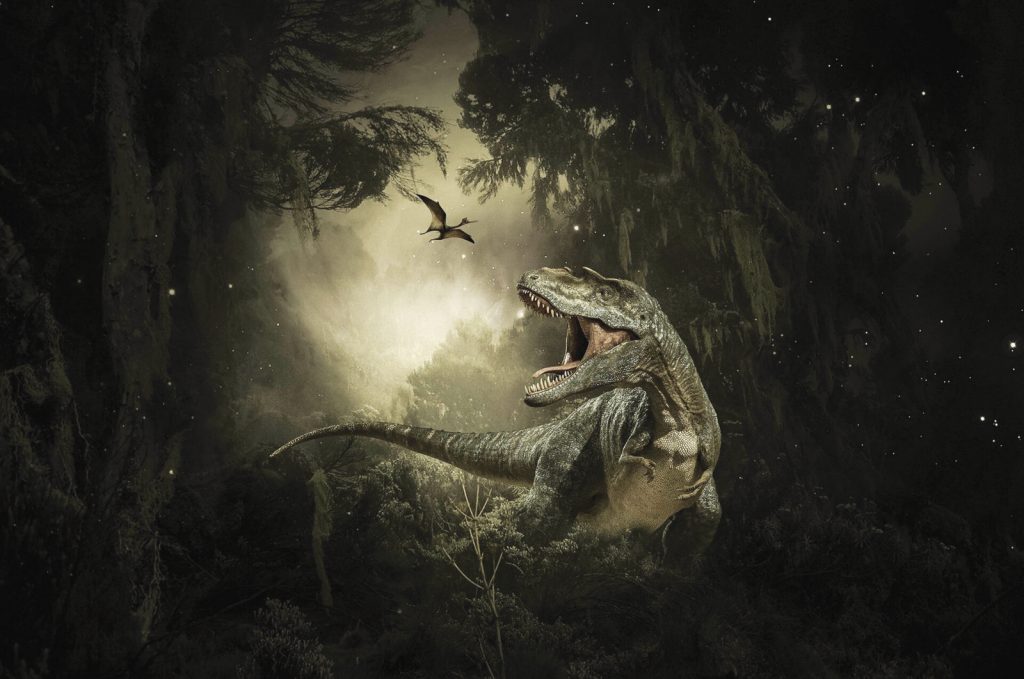
In 2016, Sean Gulick and a team of researchers extracted asteroid dust from sections of dark brown, silty claystone and greyish-green marlstone buried beneath the ocean in Mexico’s Yucatán Peninsula. Now, five years later, that dust has answered perhaps one of humankind’s most poignant questions: What killed the dinosaurs?
Gulick, a research professor at the Jackson School of Geosciences, spent over a decade sending out proposals for the mission, so when it finally commenced, and he was bunked six-to-a-cabin and sharing one bathroom with his fellow scientists for two months on a lift boat perched 15 meters above the water—much higher still above the crater they were drilling into—the intimate quarters were forgiven in lieu of the excitement of discovery. Each layer they drilled into revealed a new mystery.
“We were really excited,” Gulick says, “as we got into what were clearly materials that didn’t look anything like what you would expect in a normal sort of continental shelf.”
In a new scientific study published this February in Science Advances, UT researchers used that extracted asteroid dust to put to rest the age-old mystery of what wiped out the dinosaurs (and the ammonites and the mosasaurs). Their research points to an asteroid impact that hit Earth 66 million years ago as what led to mass extinction—not volcanic eruptions—as was first hypothesized in 1980, when asteroid dust was found in the geologic layer marking dinosaur extinction.
On the 2016 International Ocean Discovery Program mission—to drill into the Chicxulub Crater—co-led by Gulick, the scientists collected approximately 3,000 feet of rock core. According to Steven Goderis, a geochemistry professor at the Vrije Universiteit Brussel, who led the 2021 study, that mission was one of the most productive drill cores ever.
Following the mission, a 32-person group composed of scientists took its time to ensure the findings were accurate; the sample was divided among four research labs in the U.S., Japan, Austria, and Belgium to independently analyze where the actual iridium layer was located. Measuring iridium in this context is challenging due to its low concentrations, and Goderis says, “Because of this really difficult analysis—we were trailing behind.” It took some patience—four years—to get to these more substantial, ironclad results.
In the meantime, several other research studies sprang from the data collected on that research mission, helping to answer questions about the asteroid’s impact, aftermath, and recovery of life. They were fairly certain the crater was caused by an asteroid because of the element iridium, rare in the Earth’s crust, but found in high levels in certain types of asteroids. In the rock elements extracted from the crater, the researchers found a great deal of iridium. The implication drawn is that global mass extinction is tied to the asteroid impact.
It’s rare that a scientific case is ever closed—and rarer still for a researcher to say so, but Gulick says there’s no realistic argument left that the Chicxulub impact is not directly tied to the global iridium layer. Thus, the impact happened at the same time as the creation of the global layer, “which is exactly the same time as the mass extinction event,” he says. “So it’s hard not to say there’s both correlation and causation with this one.”
The extracted drill core also revealed how and when life returned to the site of the asteroid impact, and the team was surprised to discover just how quickly—geologically speaking—that occurred. Centimeters of layered sediment and nanofossils reveal a timeline, much like tree rings can be counted to determine arboreal age. All of that kinetic energy transferred into the crater, and yet, approximately 20 years following the impact, the area slowed down, grew silent, and then about 6,000 years later, life returned to the site of trauma, life that was adapted to the new conditions, and totally different than what had previously existed there. The Chicxulub crater was transformed; it was resilient. Moving forward, the scientists will compare Chicxulub crater samples to those extracted from other locations to gain a better understanding of what exactly led to the mass extinction event and how the environmental devastation occurred.
This summer, Gulick, along with colleagues from the Jackson School, will return to the crater on another mission, this time to do three-dimensional imaging of the existing drill site, as well as in the center of the crater—to inform future drilling locations. They hope to learn something fundamental about how asteroids alter the crust of the planet that they impact and also attain another high-resolution look at the aftermath of the impact.
This crater is one of the highest possible energetic geological processes known to man—it hit the Earth’s crust with such impact that it created a big hole, leading to the expulsion of gas and dust that initiated a cooling, followed by a global warming, which decimated all life for the next two decades. The local and regional environment that was heavily affected became effectively sterilized, and yet, opportune for life. While impact cratering is often thought of as a destructive process, Goderis points out that the opposite can be true.
“Something very destructive can, slightly longer term, also become a positive thing,” he says.
Credit: Willgard Krause/Pixabay
"really" - Google News
May 03, 2021 at 11:16PM
https://ift.tt/3ecUac2
UT Researchers On What Really Happened to the Dinosaurs - The Alcalde
"really" - Google News
https://ift.tt/3b3YJ3H
https://ift.tt/35qAk7d
Bagikan Berita Ini














0 Response to "UT Researchers On What Really Happened to the Dinosaurs - The Alcalde"
Post a Comment